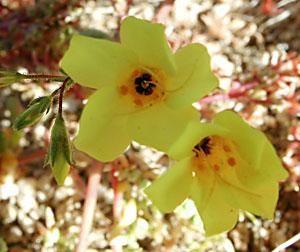
Monardella odoratissima is a perennial flowering plant. It is a member of the mint family Lamiaceae. It has the minty odor characteristic of this family. In 2020, Monardella villosa was included in M. odoratissima. As of April 2024, acceptance of the inclusion varies.

Erigeron divergens is a species of flowering plant in the family Asteraceae known by the common name spreading fleabane. It is native to western North America.

Cirsium neomexicanum is a North American species of thistle known by the common names New Mexico thistle, powderpuff thistle, lavender thistle, foss thistle and desert thistle.

Galium californicum is a species of flowering plant in the coffee family known by the common name California bedstraw.

Phacelia sericea, the silky phacelia or blue alpine phacelia, is a showy perennial species of Phacelia endemic to western North America. It grows mainly at subalpine to alpine elevations in forest openings or above treeline among rocks and sand. Sericea comes from the Latin sericeus, or silky, referring to the fine hairs on the leaves and stem.

Chrysothamnus viscidiflorus is an American species of shrub in the family Asteraceae known by the common names yellow rabbitbrush and green rabbitbrush.

Crepis runcinata is a North American species of flowering plant in the family Asteraceae known by the common name fiddleleaf hawksbeard. It is native to western and central Canada, the western and central United States and northern Mexico (Chihuahua).

Erigeron petrophilus is a species of flowering plant in the family Asteraceae known by the common names rockloving erigeron or cliff fleabane. It is native to the mountain ranges of California from Siskiyou County south as far as San Luis Obispo County and El Dorado County. It also grows in southwestern Oregon.

Leptosiphon aureus is a species of flowering plant in the phlox family known by the common name golden linanthus.

Dieteria canescens is an annual plant or short lived perennial plant in the family Asteraceae, known by the common names hoary tansyaster and hoary-aster.

Monardella hypoleuca is a species of flowering plant in the mint family, known by the common names thickleaf monardella and white leaf monardella.
Monardella linoides is a species of flowering plant in the mint family known by the common name flaxleaf monardella.

Penstemon janishiae is a species of penstemon known by the common names Antelope Valley beardtongue and Janish's beardtongue. It is native to the northwestern United States in sections of Idaho, Oregon, Nevada and northwestern California, where it is a member of the flora in sagebrush, woodland, and pine forests. It is a perennial herb with several hairy upright stems reaching up to about 25 centimeters tall. The leaves are up to 6 centimeters long, many located around the base of the plant and several pairs along each stem. The inflorescence produces several wide-mouthed tubular flowers 2 to 3 centimeters long. Each hairy, glandular flower is pale purple to pinkish or bluish in color with a dark-lined, pouchlike throat. The mouth of the flower is hairy and the protruding staminode is coated in bright orange or yellow hairs.

Penstemon papillatus is a species of penstemon known by the common name Inyo beardtongue.

Penstemon personatus is an uncommon species of penstemon known by the common name closethroat beardtongue.

Peteria thompsoniae is a species of flowering plant in the family Fabaceae known by the common names spine-noded milkvetch and Thompson's peteria. It is native to the western United States, where it grows in salt desert shrublands in soils of volcanic ash origin, and in alluvial fans. It is a spiny perennial herb growing from a taproot and rhizome system, its stem growing 20 to 60 centimeters tall. The leaves are made up of several pairs of oval leaflets. The inflorescence, a spikelike raceme at the top of the stem, produces white or pinkish pealike flowers up to 2.5 centimeters long, its base encapsulated in a tubular calyx of glandular sepals. The fruit is a leathery, slightly inflated legume pod up to 6 centimeters long.

Sidalcea oregana is a species of flowering plant in the mallow family known by the common name Oregon checkerbloom.

Erigeron tweedyi, or Tweedy's fleabane, is a perennial herb in the family Asteraceae. It is native to the Rocky Mountains in Montana, Idaho and Wyoming.

Chionophila tweedyi, or Tweedy's snowlover, is a perennial herb in the plantain family. It is native to Idaho and Montana in the western United States.

Penstemon caespitosus, commonly known as mat penstemon, is a summer blooming perennial flower in the large Penstemon genus. It is a widespread plant from near timberline to the foothills in the Southern Rocky Mountains and Colorado Plateau in North America. It is noted for its ground hugging growth habit and as a plant used in xeriscape and rock gardening.




















